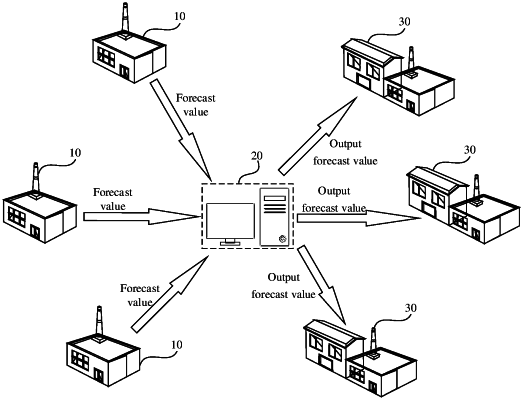| CPC G06Q 10/04 (2013.01) [G01W 1/10 (2013.01); G06N 20/00 (2019.01); H02J 3/004 (2020.01); H02J 3/381 (2013.01); H02J 2300/24 (2020.01)] | 12 Claims |

|
1. A computer-based method of deep learning model training and processing an irradiation forecast by way of a trained deep learning model, the method comprising:
receiving from a plurality of meteorological observatories historical irradiation forecast data and historical measurement values;
training a deep learning model comprising a stacked generalization model with the historical irradiation forecast data and historical measurement values, wherein the stacked generalization model comprises a first-layer generalizer and a second-layer generalizer, wherein each of the first-layer generalizer and the second-layer generalizer is a learning model, and wherein training the stacked generalization model comprises:
constructing n training samples, each of the n training samples comprising historical irradiation forecast data corresponding to one historical time period and historical measurement values of plane of array irradiation within the historical time period, wherein n is an integer greater than 1;
choosing m training samples from the n training samples, wherein m is a positive integer greater than 1 and less than n;
training the first-layer generalizer using historical irradiation forecast data of the m training samples and measurement values of the m training samples, to obtain a trained first-layer generalizer;
determining intermediate historical forecast data of n-m training samples based on historical irradiation forecast data of the n-m training samples using the trained first-layer generalizer, the n-m training samples being the training samples other than the m training samples in the n training samples; and
training the second-layer generalizer using the intermediate forecast data of the n-m training samples and historical measurement values of the n-m training samples to obtain a trained second-layer generalizer;
acquiring from at least one meteorological observatory irradiation forecast data corresponding to a target time period, wherein the irradiation forecast data corresponding to the target time period comprises at least one forecast value of plane of array irradiation within the target time period;
calling the stacked generalization model;
determining intermediate forecast data based on the irradiation forecast data corresponding to the target time period using the first-layer generalizer; and
determining an output forecast value corresponding to the target time period based on the intermediate forecast data using the second-layer generalizer.
|